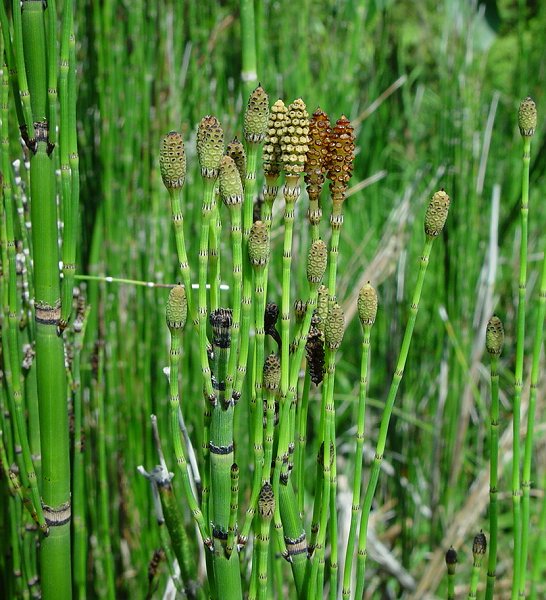Equisetum hyemale L.
Common Scouring Rush

Native
CC = 3
CW = -3
MOC = 80
© DETenaglia
Equisetum hyemale L.Common Scouring Rush | |
 |
Native CC = 3 CW = -3 MOC = 80 |
© DETenaglia |
|
Family - Equisetaceae Habit - Rhizomatous perennial forb, with sporangia aggregated into dense strobili. Stems - Monomorphic, erect, to 1.6 m, persistent for more than 1 year, green, hollow, roughened, 14-50-ridged, jointed at nodes, unbranched or sometimes irregularly branched at some nodes.
Leaves - Whorled, highly reduced, fused for part of their length to form a collarlike sheath around the stem. Sheath with a broad dark band near the base, usually also with a white band in the middle and a thin, dark band at the tip, with small teeth along the tip of the sheath, these sometimes persistent at maturity, narrowly triangular, attenuate, black. Sporangia - Saclike, in whorls on the underside of highly modified leaves (sporangiophores), these peltate, hexagonal in surface view, and aggregated in dense whorls into conelike strobili occurring at the stem or branch tips. Strobili 1.0-2.5 cm long, the tips rounded to an abrupt, sharp point.
Spores - Globose, 35-70 μm in diameter, green, each with 4 spirally curled, white filaments (elaters) that uncurl and spread apart upon drying, aiding in dispersal. Gametophytes green, growing at or near the soil surface, disk- to cushion-shaped, irregularly lobed.
Flowering - March - August. Habitat - Ditches, roadsides, moist to wet ground, railroad embankments. Origin - Native to the U.S. Lookalikes - E. laevigatum. Other info. - This interesting species is common throughout Missouri and occurs from coast to coast across the continental U.S. Of the three species of Equisetum in Missouri, this one is by far the most common. It is easily recognized by general appearance, although the less common E. laevigatum can appear similar. That species has stems which are smooth and leaf sheaths with only a thin dark band near the top. Under favorable conditions, E. hyemale is an aggressive species and can form large, dense colonies. Photographs taken in Gainesville, FL., 7-21-02 (DETenaglia); also along the Katy Trail southeast of Dutzow, Warren County, MO, 6-21-2010, 6-30-2019, and 4-3-2022 (SRTurner). |